The Many Layers and Complicated Hierarchy of the English Football Pyramid Tiers
While all the national leagues have them, there is an aura of speciality about the English football pyramid tiers. The sheer size of it rivals the ones in Giza.

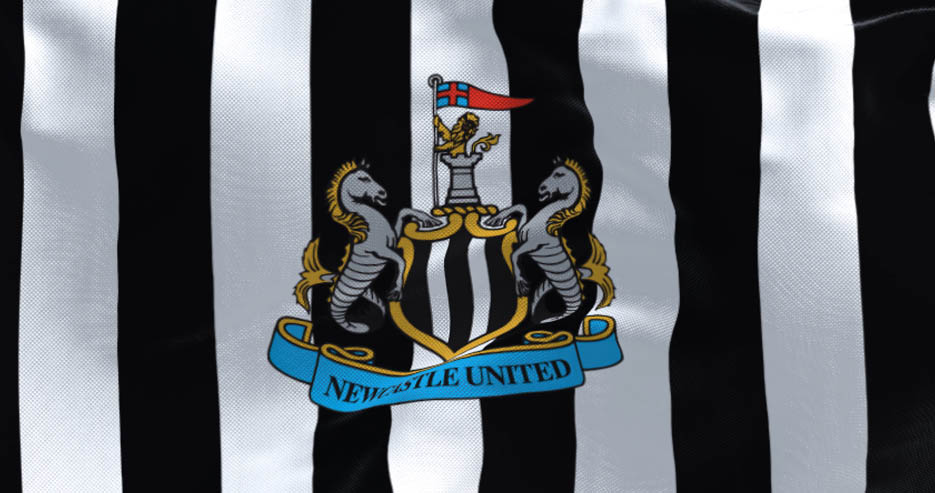
Accusations that they are an instant club are coming. That's the cost of welcoming wealthy owners, paid before by both Chelsea and Manchester City. Yet, Newcastle United fans might have the clearest right to oppose such claims as they were the biggest of the three before billions poured into them.
To discount and snub off NUFC as a new plaything for the confusingly rich is not knowing your football history.
It's to be inexplicably blind for the passion of its faithful fans that turn to England's most tireless travellers every other week. The deafening hosts in between.
It's to skip on the loyalty lesson that was the sole shining beacon in the dark nights of the past seasons.
It's to lose out on a rare story of football defining - without skipping a soul - an entire city.
Newcastle United, it's been a long time coming.
Even though the late 19th century seems like such a prehistoric start to the modern behemoths that are modern-day football clubs, it's a general sentiment that the game flourished late in the North East of England.
The first game in the region precisely known as Tyneside was played in 1877, although the teams weren't able to bolster full ranks. Eight versus nine men it was.
That is in 1890 that the sport truly began to take off – several years after football had begun to seep into the very fabric of society in other parts of the UK.
Two, or three clubs - depending on how you look at it - located in the city are linked with the beginning of NUFC, one of them being Stanley, stemming from a cricket side. Formed in November of 1881, yet they were confused with another team in the area, so they changed their name to Newcastle East End.
Rosewood was another football club formed in that period, and they later merged with Newcastle East End, becoming their reserve side.
Out on the west side, a different club was making decisions that were to be linked with NUFC we know today - West End Football Club. Playing their games on the cricket field first, but eventually moving across the Tyne River to a pitch since then referred to as St. James' Park.
As East End became a limited company, they got the upper hand in the financial competition with the city rivals on the other side. Seeing how the city wasn't large enough for two sides - and remains so in a way - West End offered the lease of St. Jame's Park to East End in 1892. Alongside the grounds, the struggling West End handed over remaining assets, including some of its players.
East End's first game at St. James’ Park took place on 3rd September of 1892 against Glasgow Celtic, won by the visitors 1:0. The friendly was played in front of 6,000 people, yet that wasn't the norm.
In a desire to draw in more people, the decision-makers met and decided the club needs a name that would be more inviting for all people living in the city. Several names were suggested, none made more sense than Newcastle United.
Hence, Newcastle United was founded on 9th of December, 1892.
Embroided in the black and white stripes, yet Newcastle United’s history started in red. Those are the shirts worn by the East End club But in 1894 the newly formed club switched to black and white stripes and never looked back.
The year prior, in 1893 the club tried to get into the First Division, the top tier of English football then. Yet they were refused and offered a place in the second league. Understanding that they have to get a foothold somehow, NUFC accepted and entered the lower tier with two other familiar names - Liverpool and Arsenal.
After the formatting seasons in the North division of then not so regulated English football, Newcastle United joined the second tier in the 1893/1894 season. Playing 28 games and getting the fourth position in their first proper season.
The side would stay on the edge of the elite finishing 10th, 5th, 5th again, before getting the promotion with a second spot placement in the 1897/1898 season.
After five years spent in the second tier, Newcastle United took only seven seasons to achieve their major goal - becoming the champions of England.
The inaugural season in First Division saw them placed 13th, the following spots were 5th, 6th, 3rd, 14th, and 4th.

By Unknown author - Here, Public Domain, Link
Then in the 1904/1905 season the club won their first-ever trophy. The big one. Winning in a competition of 18 clubs, just edging Everton in the then-still two-points-per-win system. Manchester City and Aston Villa followed.
Since 1903/1904 season actually, Newcastle United had a peculiar trend of finishing fourth then first in the following season.
So after winning the league in 1905, they were fourth by the end of 1906. In 1907 they won the then 20-teams league again ahead of Bristol City and Everton. The following 1908 finished well behind Manchester United.
But in 1909, the team again won the trophy. Once again, ahead of Everton. In 1910, this see-saw of fourth-first was completed, as Aston Villa took the trophy.
The side then didn't come close to the winning the trophy again until they did achieve it inn 1926/1927. Overcoming Huddersfield Town in the title race that had 22 clubs at the start. This is the last time Newcastle United won the title.
Actually, since then, the first notable route was down. In the seventh season following their triumph, the side was relegated. It was the 1933/1934 campaign that saw them placed 21st of the 22 teams. Despite beating Liverpool 9:2 and Everton 7:3 within one week that season.
Newcastle United stayed in the second tier until 1947/1948.
With the note that football wasn't played during World War I and World War II.
Yet this second stint in the Second Division was the longest for the club even counting out the years of war - eight long seasons.
Being a top-of-the-table side for the first three years of the resurgence, yet fell into the lower end of the rankings thereafter. Before returning to the second show in the 1960/1961 season. Again placing 21st.
For four years the side attempted to get back to the big league, achieving so in the 1964/1965 campaign.
A fairly uneventful era on all fronts ensued, with 12 seasons of no notable results.
Until, Newcastle United found itself back in the second division following finishing 21st in the 1977/1978 season.
Five seasons in the second division until resurging back into First Division after the 1983/1984 season.
Yet, by the end of the century, United was back playing in the second divison, after getting relegated in 1989.
The following four years are the last consecutive seasons in which Newcastle was out of the elite.
While United was out, the Premier League was formed and United seemingly turned a new leaf upon entering. Finishing the first two seasons back amongst the best 3rd and then 6th.
Then, in the 1995/1996 and the 1996/1997 seasons NUFC was the runner-up. Both times behind Manchester United.
Coming so close to the goal but failing took its toll on the squad and four mid-table finishes ensued. Despite their biggest son Alan Shearer getting 30 goals in the first season following the two kicks in the teeth.
The team bounced back in the 2011/2002 seasons, finishing fourth and getting the spot for the Champions League qualifications. While the following year they were 3rd.
United exited the Premier League in the 2008/2009 season after finishing 18th.
Yet the team bounced back immediately, winning the Championship.
Same thing happened in the 2015/2016 season. Once again, Newcastle United was 18th and relegated, and once again, the team won the Championship immediately. Being a mid-table side since, for five seasons.
All in all, Newcastle United spent 29 seasons in the second tier of English football.
Considering the amount of money poured into the club, the fans can forget worrying about relegation at all.

By EclecticArkie - Own work, CC BY-SA 4.0, Link
By going through the league rankings of Newcastle United, we saw that they won four championships: 1904/1905, 1906/1907, 1908/1909, 1926/1927.
The side also won the second division four times: 1964/1965, 1992/1993, 2009/2010, 2016/2017.
If the haul in the league seems like too much of a distant past, Newcastle United has found more success in the seminal English cup competition.
The squad won their first FA Cup in the 1909/1910 seasons, at the end of their 4th to 1st cycle we wrote about.
In overall 12 finals, the team was triumphant six times!
Winning in total: 1909/1910, 1923/1924, 1931/1932, 1950/1951, 1951/1952, 1954/1955.
Clearly, the '50s were the most fertile grounds for Newcastle, with three triumphs in five seasons. Games played at Wembley with crowds of over 100,000!!!
All while the team wasn't performing at their es in the First Division, finishing 4th, 8th, and 8th again in their FA Cup-winning seasons.
In the League Cup, NUFC wasn't as successful. Their only final before the 2022/2023 one was in the 1975/1976 season, with the same result - loss.
Newcastle won their sole Charity Shield trophy in 1909, falling short in the 1951, 1952, 1955, and 1996 games.
NUFC also achieved European success, unfortunately, in the now-defunct competitions. The side won the Inter-Cities Fairs Cup in the 1968/1969 season!
Their run was impressive, beating Feyenoord Rotterdam, Sporting Lisbon, Real Zaragoza, Vitoria Setubal, and then Rangers over two legs to go to the final.
In it, also in two legs, United beat the Hungarian side Ujpest with an aggregate of 6:2 (3:0; 2:3). The 2006 European trophy came in the now also defunct UEFA Intertoto Cup. Although, a triumph here is also nominal as it only brought a continuation of competition in the UEFA Cup.
Newcastle United won other minor trophies, like the continental Anglo-Italian Cup in 1973, beating Fiorentina in the finals.
Sheriff of London Charity Shield, a game played annually between the best amateur and best professional club in England, was won in 1907, the last year it was played officially.
Alongside two Texaco Cup titles, in 1974 and 1975, a now-defunct competition for Irish, Scottish, and English teams that didn't qualify for European tournaments.
Throughout the years, even though the players and the fans were representing the club with the black and whites since nearly the beginning, the club crest didn't reflect it.
From 1969 to 1976 the club was represented by the crest identical to the coat of arms the city of Newcastle upon Tyne had as its symbol. Even though it was sawn into the shirts long before, even in 1911, it only officially became the crest in 1969.
With the motto in Latin "Fortiter Defendit Triumphans" written below. In English, it clearly echoes the name of the city - Triumphing by brave defence.
It wasn't really fitting with the era of Alan Shearer, though.
From 1976 to 1983 Newcastle United club had a very English football club like crest, with a magpie in front of a medieval Castle Keep in the city. The crest also showed the river Tyne flowing ahead.
The club's next crest was well ahead of time, but luckily it is a thing of the past. Even though the over-simplistic crest remains a cult favourite amongst some, it lacks the artistic beauty of the other versions. A lone magpie is covered by a rotated letter 'C', on top of which the stylized letters 'NUF' stand. Making for NUFC altogether.
Luckily, it was the official mark for only five years, from 1983 to 1988.
The current crest replaced it, combining the colours of the club with the elements of the coat of arms. Two seahorses guard a shield of black and white stripes, on top of which we see a castle keep and a lion soaring a flag. With the club's crest topped by a sash containing the name of the club.
Known primarily as The Magpies, it's clear to see how the comparison came to be as the black and white bird resembles the shirts Newcastle players wear.
The Newcastle United mascot is hence a Magpie itself, called Monty Magpie.
But that is not the only nickname of Newcastle United, nor of its fans.
Commonly known also as The Toon, as that is how the people of the area pronounce "town" with their accents. Hence, the supporters of the club are also famously known as the Toon Army. While the people of North East England, and particularly of the Tyneside - area around the river Tyne - are known as Geordies. So you often hear that term used to refer to the Newcastle faithful.
Even the St. James Park has a nickname to illustrate just how much football means to the locals - The Cathedral on the Hill.

A hospital and chapel named St. James’ were located near the area where the football pitch was first established. Naturally, the ground picked up the name as well.
Seven years since East End and West End Newcastle United, first major construction developments started on the stadium. The capacity - of course standing - was set at 30,000. Yet only six years later it was doubled!
The ground was introduced to floodlights in 1953 and five years later they were upgraded. The main West Stand terrace - the first covered one - stood for 82 years before it was demolished for safety concerns in 1987. Then, United had two major side terraces with two sections - upper and lower, seated and not - with small areas behind the goals.
St. James' Park was built almost like the Sagrada Familia in Barcelona. Over time, bit by bit. In 1993 the club built another stand and continued the renovation by filing in the corners of the place.
As Euros in England 1996 were incoming, the club had an all-seater stadium with a capacity of 36,610.
In the year 2000, the final - so far - expansion was made to the stadium. At the cost of €48,500,000, the stadium's capacity was improved to north of 52,000!
Now, the capacity of St. James' Park is 52,354!
It's the eight largest club football stadium in England.
During the era of the infamous owner Mike Ashley, the owner of the Sports Direct sporting goods corporation, the stadium lost its name. Officially that is. In 2011 it was renamed to Sports Direct Arena. Yet the new owners coming in 2022 have quickly rejoiced about the prospect of removing the add banners from the construction of the stadium.
St. James' Park has memorials for four players who have marked the club's history spanning over 131 years! Joe Harvey, both a player and a manager for NUFC, got a plaque in 2014! Prior to him, in 1991, the striker Jackie Milburn got a statue, three years after his passing.
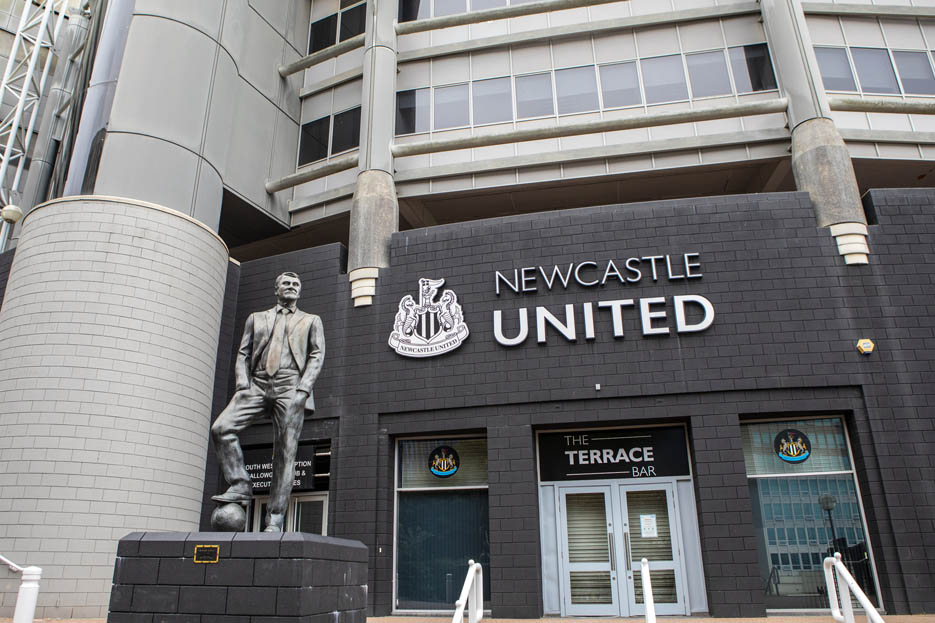
Bobby Robson's statue holds a ball firmly under him, garnering a suit and tie to illustrate his managerial years with Magpies. Accompanied by the man he managed, Alan Shearer, having a typical, albeit eternal celebration.
Will anyone from the current crop of players earn enough love and admiration of the town - or Toon - obsessed with football, time will tell. Yet they are seemingly in a better position than any of the men before them, with unprecedented investments flowing into the club. Transfer records getting broken every new window as the likely norm.
Although that means that some of the current players closing up to the record books, like Jamaal Lascelles and Paul Dummett, will have fiercer competition for history.
A common slogan associated with NUFC is "A town united" as the entire city area that holds up to around 700,000 people doesn't have a major or even a minor football club rival.
The closest side to Newcastle is Gateshead, across the river. A club that competes in the fifth tier of the English football pyramid and have never competed in the same league as Newcastle. So a proper rivalry was never on the cards.
That's why the club's biggest rivals are Sunderland, another close major town. Just 16.4 kilometres between the grounds of the two clubs, as the crow or magpie flies.
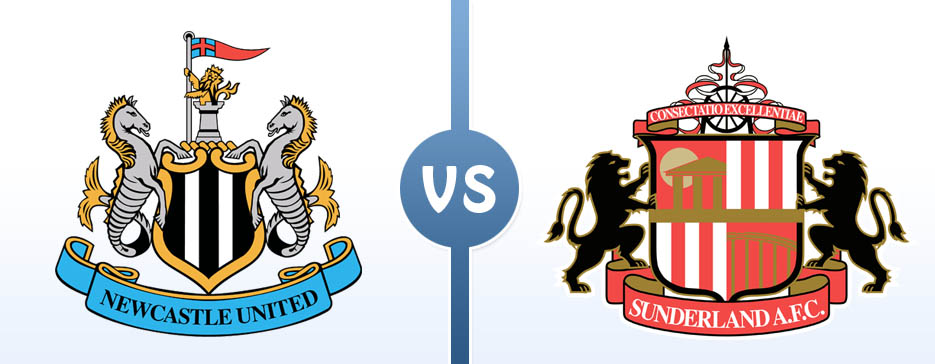
Called the Tyne-Wear derby - as Sunderland is placed on the river Wear - is one of the fiercest rivalries in English football!
As is tradition in England, the rivalry stems from history and more serious matters. Similiar and nearby, it's only logical that the two cities would but heads, yet in England it had an added dose. Sunderland believed that Newcastle merchants were being favoured as the city was royalists, while Sunderland was a parliamentarian stronghold.
At the moment of writing this article in April of 2023, with 156 games played, the sides were strikingly equal - both claiming 53 wins over their rivals. Alongside 50 draws. In such a narrow comparison, Sunderland fans will point out that their team scored more goals, eight of them 232 to 224!
Of course, that is untill First Division titles get brought up, which Sunderland has more too 6:4. Yet NUFC wins in the FA Cup stands 6:2.
Yet, the more concerning matter is that the teams didn't meat each other since the 2015/2016 season, due to Sunderland falling out of the elite. The last match also ended on an equal bearing - 1:1 with Aleksandar Mitrović and Jermaine Defoe scoring.
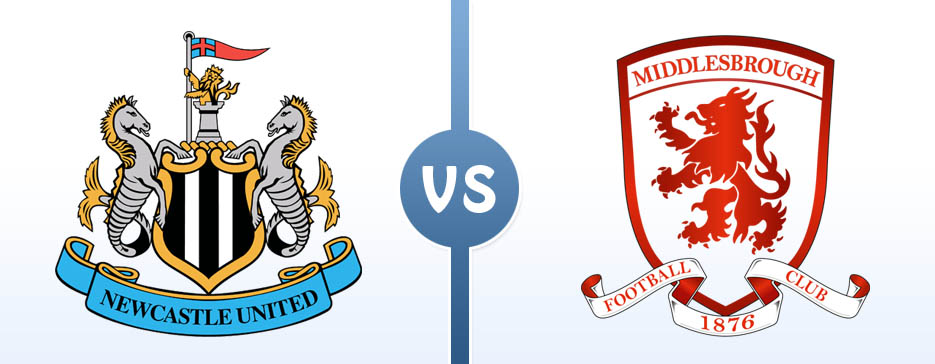
Another rivalry Newcastle United maintains is the Tyne-Tees derby, with Middlesbrough, another side in the North-East of England. Once again, another derby where the rivers get the naming rights. Yet, as Sunderland stands between the two cities, the rivalry isn't as fierce between Newcastle and Middlesbrough.
Although the importance of it did rise whenever Sunderland was out of the Premier League and Middlesbrough was the closest regular rival of Newcastle. Which happened in the 1990s and early 2000s.
NUFC has the better record here, with 51 games won, 38 drawn, and 40 lost. The two sides last met in 2010.
Yet the North-East is seemingly thirsty of rivalries as the last game these two sides played was in 2010, ending 2:2. Alas, it was in the Championship, so the stakes weren't as high as possible.
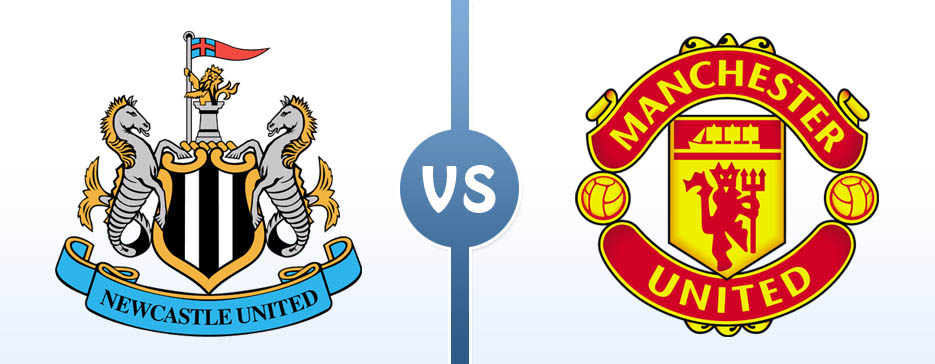
As there aren't enough North-East derbies for The Toon army to satisfy its combative nature, there is the north derby with Manchester United.
Of course, the reasoning isn't just the lack of other derbies, as Man United has been a major chip in the eye of Newcastle. The closest Newcastle United came to a title in the modern Premier League era, it was outshined by Manchester.
In 176 games the two Uniteds met, the more succesful team won twice as many games! The Red Devils got the whole spoils 91 times, the match was drawn 41 times, and NUFC won on 44 ocassions!
Not to mention that Manchester is the team that fills the stats of Newcastle United's heavies defeats. Barraging their rivals 6:0 in 2008 and 1968, and 7:2 in 1976!
Yet, with the new era of Newcastle United coming, this rivalry is set to be even bigger than ever. With The Toon army hoping for years of payback.

While all the national leagues have them, there is an aura of speciality about the English football pyramid tiers. The sheer size of it rivals the ones in Giza.
There are reigns and then there are absolute dominations like these longest title streaks in the top five leagues.
We’re pretty sure that even corporate board members have a tough time tracking all the Red Bull soccer teams around the world. Here’s a guide!
Biggest, greatest, strongest. These topics are usually discussed way more than the important question of what are ost supported football clubs in the world.
High-profile transfers are coming in each window, big names, yet some current Newcastle United players made heavy impact at the club.